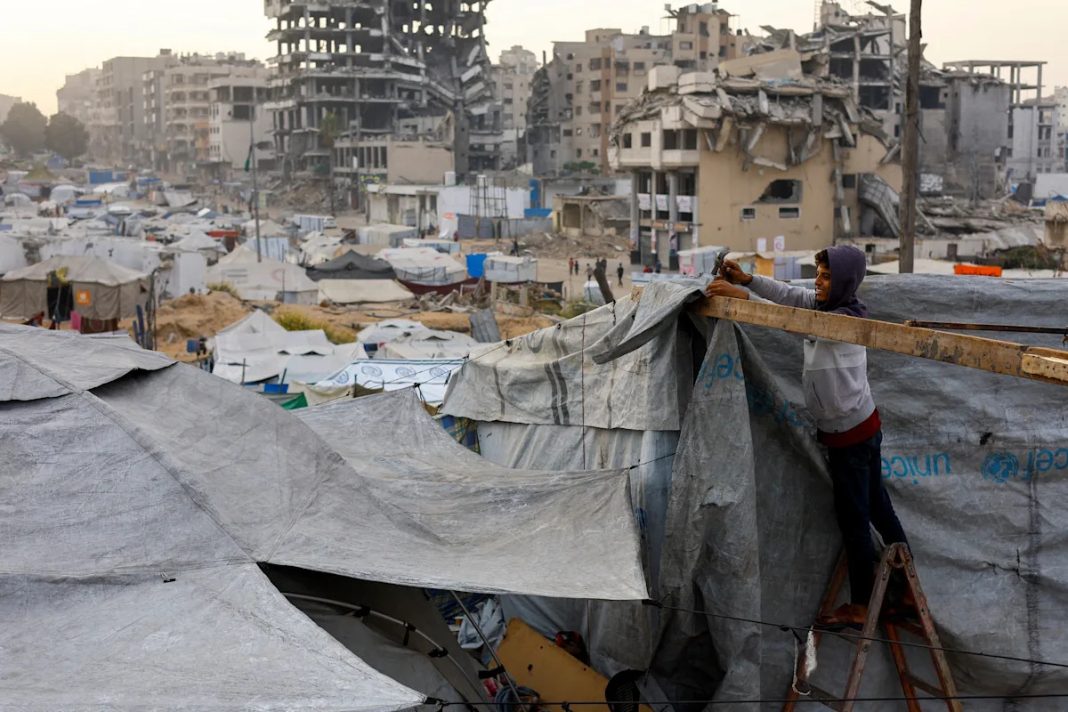For Gaza resident Yassir Shaheen, nights were the hardest part of living through Israel’s devastating two-year war on the enclave.
“Many nights, we lay awake, our lips dry, our hearts pounding in fear, feeling as though the sky itself was collapsing on us,” he told Al Jazeera.
The Strip lies in tatters – its economy destroyed, infrastructure in ruins, and its people displaced, as a fragile US-brokered truce barely holds. More than 68,000 Palestinians have been confirmed killed, with some 10,000 still buried under the rubble, according to Gaza’s Health Ministry.
As world leaders in the Qatari capital Doha pledged this week to “leave no one behind” at the United Nations Second World Summit for Social Development (WSSD), the commitments stood in stark contrast to the reality in Gaza, where access to basic needs remains a luxury.
“Even bread can feel out of reach,” Shaheen, the team lead for the charity Humanity First UK in Gaza, revealed.
Food distribution by Humanity First UK in Gaza [Courtesy of Humanity First UK]
While prices have fallen compared with the worst periods of the war, they are still six to 10 times higher, Shaheen said.
On Thursday, Gaza’s Government Media Office said Israel has only allowed 4,453 trucks to enter, barely a quarter of what was supposed to enter daily according to the ceasefire agreement that came into effect on October 10.
Meanwhile, infrastructure in the enclave has been almost completely destroyed, Shaheen lamented, with only rubble remaining “where streets and buildings once stood”.
According to UN estimates, 92 percent of all residential buildings in Gaza have been damaged or destroyed since Israel’s war on the enclave began on October 7, 2023, producing between 55-60 million tonnes of rubble.
“Schools, clinics, shops, homes … everything that allowed life to function has been reduced to dust,” he said
Development ‘impossible’ amid lack of rights
At the WSSD this week, which concluded on Thursday, member states repledged commitments made at the 1995 summit in Copenhagen, including the eradication of poverty, providing “decent” work, social integration, education and healthcare to the world’s most vulnerable populations.
The resulting Doha Political Declaration, adopted at the end of the summit, was a “booster shot for development”, UN Secretary-General Antonio Guterres said.
Nevertheless, global declarations such as the WSSD do little in the face of the dire situation in Gaza, according to Rohan Talbot, director of advocacy at the UK-based Medical Aid for Palestinians.
“Despite the ceasefire, the situation in the health sector remains catastrophic, with severe shortages of medical equipment and medicines, and hundreds of healthcare workers killed or still detained,” he told Al Jazeera.
“Development is impossible while Palestinians are denied the most basic rights to safety, movement, and dignity.”
Echoing Talbot, the head of Humanity First UK, Aziz Hafiz, said “no declaration, however eloquent, can substitute for the fundamental right to freedom and security”.
“Development cannot flourish in isolation from justice and peace,” he told Al Jazeera. However, he asserted that does not mean “we wait for peace to act.”
“Every vocational programme, school rehabilitation, or psychosocial initiative becomes an act of resistance to despair,” he said. “While permanent peace remains the ultimate enabler of prosperity, maintaining human dignity in the present moment is equally critical.”
MAP’s Talbot asserted that for any “meaningful development”, the international community must ensure that humanitarian law is upheld.
“There must be genuine pressure on the Israeli government, as the occupying power, to enforce a permanent ceasefire, open the crossings, and allow the unrestricted entry of aid and medical supplies for thousands of injured Palestinians,” he said.
‘Rebuilding feels like a dream’
After two years of relentless Israeli attacks and destruction, Shaheen said what Palestinians most want in Gaza is to “rebuild [their homes] with their own hands, and to regain a piece of normal life again”.
“Living in the displacement camps is one of the hardest things people are going through now,” he pointed out.
“Most people have no real shelter, only thin, flimsy tents that barely stand against the wind. There’s no space, no privacy, no comfort. When it rains or when the sun burns, there is nowhere to escape.”
However, Shaheen says the scale of devastation raises painful questions about what rebuilding looks like.
“How long will it take just to remove the rubble? We hear that it could take years. And if clearing the debris takes that long, then how long will it take before rebuilding can even begin?” he said.

A view of the heavily damaged Jabalia neighbourhood in northern Gaza [File: Anas Zeyad Fteha/Anadolu Agency]
But more importantly, for Shaheen, rebuilding is not just about “concrete and walls”.
“It is about rebuilding their lives, their sense of safety, and their dignity. They do not just want buildings to rise again, but life to return.”
Israel has violated the ceasefire at least 80 times, according to the Gaza Government Media Office. More than 240 Palestinians, including dozens of children, have been killed by the Israeli army since the ceasefire began.
MAP’s director of advocacy Talbot said the only path to sustainable peace and development in the Strip were “justice and accountability” for the atrocities committed.
“Declarations and summits will remain hollow exercises unless they are matched with political will to end the root causes of Gaza’s suffering, including Israel’s ongoing military occupation and blockade,” he said.
“Palestinians must have self-determination to lead their recovery and define what their future will look like.”

